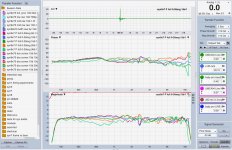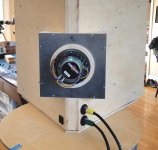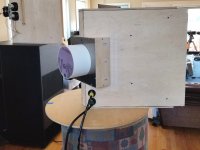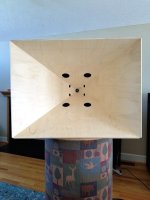OK. I don't get one thing. How does SMAART establish the actual delay on each measurement? I know in ARTA, single channel, the software 'picks' a delay time up to (I believe) 20% of the top of the impulse. But that method obviously has flaws when using different bandwidth sources.Also, (something i haven't mentioned yet), for moving mic averages Smaart can automatically readjust its delay finder (loopback timing), so that each transfer function captured is with excess delay (TOF) removed (24 transfers per second). Iow, phase is also correct for averages, with moving mic .
I have been contemplating to have the Synergy placed, so that the loudspeaker fires up in the sky. And then construct some kind of a movable/rotating frame (rotating around the throat of the horn) to hold the microphone for polar-measurement.
This arrangement should prevent most neighbor-complaints.
Would it be a god idea in respect to reflections also? Given that I place the measurement-stand some 25-30 feet away from the house.
What matters is the shortest distance from the speaker to the nearest surface as that will be the limit to any gating or whether the measurement makes any sense without gating. Generally this will be the floor so unless you raise the speaker off the ground it won't help.
You can dig a hole and make a half space measurement straight up but that will not be the same response as in free space.
Wrt ground plane measurements. The only thing that has to be on the floor is the microphone. So you only have to dig a tiny hole.
You can dig a hole and make a half space measurement straight up but that will not be the same response as in free space.
Thanks. 🙂
That would correspond to the Loudspeaker being mounted in a huge baffle/frontwall I guess!? Hmm
I do look forward to gain a better understanding of measurements and how to assess them!
Steffen
If the speaker isn't on the ground for a ground plane measurement there will be reflections between it and the floor. The question above was about firing the speaker up though.Wrt ground plane measurements. The only thing that has to be on the floor is the microphone. So you only have to dig a tiny hole.
Yes half space / Infinite baffleThanks. 🙂
That would correspond to the Loudspeaker being mounted in a huge baffle/frontwall I guess!? Hmm
I do look forward to gain a better understanding of measurements and how to assess them!
There is a good thread here that would be worth reading
Measuring Response: How close is "close enough" to anechoic?
OK. I don't get one thing. How does SMAART establish the actual delay on each measurement? I know in ARTA, single channel, the software 'picks' a delay time up to (I believe) 20% of the top of the impulse. But that method obviously has flaws when using different bandwidth sources.
When in real-time transfer function mode (like ARTA's FR2 mode), Smaart simultaneously runs a 'live impulse'.
The live impulse uses shorter FFT sizes for timing accuracy, than normally used for Smaart's Impulse Response mode.
ARTA doesn't seem to have a limit on the number of impulses it will average?
If it will average a bunch of generations, i think it could work well like Smaart for killing noise. Will try it first chance.
Have you used it's averaging much?
I have been contemplating to have the Synergy placed, so that the loudspeaker fires up in the sky. And then construct some kind of a movable/rotating frame (rotating around the throat of the horn) to hold the microphone for polar-measurement.
Some of the worst measurements I've ever made have come from trying to do that. It is amazing to me how laying a speaker on its back, on the ground, plain doesn't work.
It's worth a try just to get amazed yourself haha 😀
Yup. The microphone being IN the floor will indeed pick up those 'reflections'. And they will all be 100% in phase with the source (pathway differences all are zero). So your mike effectively turns into a half space measuring instrument. That, at least in theory, is the fun of it. You'll have to use a good reflecting floor surface.If the speaker isn't on the ground for a ground plane measurement there will be reflections between it and the floor.
Outdoors yes. But mostly no more than 4 to 5 averages. Indoors there seldom is need for it.Have you used it's averaging much?
Found a donateware that may be just the thing? I won't have time to investigate for a few days but it looks promising. Installed on laptop and it looks like it might do the real time dual channel smaart thing.
Open Sound Meter
Had to use wayback to find the overview.pdf instructions.
Releases * psmokotnin/osm * GitHub
Open Sound Meter
Had to use wayback to find the overview.pdf instructions.
Releases * psmokotnin/osm * GitHub
Thought about this. It likely only works with sources with comparable lowpass functions, as the analyzer still will pick a certain SPL for reference phase. Just like ARTA does. Don’t compare woofers with tweeters then.When in real-time transfer function mode (like ARTA's FR2 mode), Smaart simultaneously runs a 'live impulse'.
The live impulse uses shorter FFT sizes for timing accuracy, than normally used for Smaart's Impulse Response mode.
@ hornsteff, I really like groundplane..speaker and mic both on hard ground surface .
Like in discussed in the thread fluid linked in #105.
@ Kevmoso, yep, i've seen that one but never dug in. Pls let us know if you get it working well.
@ markbakk, Smaart's delay finder works well for all of the sections my 4 & 5-ways.
I also think I've learned a few tricks that aid in getting subs and mid bass sections' timings correct....(the problem child sections).
Will be happy to share them if anyone cares.....(they do use FIR though)...
Like in discussed in the thread fluid linked in #105.
@ Kevmoso, yep, i've seen that one but never dug in. Pls let us know if you get it working well.
@ markbakk, Smaart's delay finder works well for all of the sections my 4 & 5-ways.
I also think I've learned a few tricks that aid in getting subs and mid bass sections' timings correct....(the problem child sections).
Will be happy to share them if anyone cares.....(they do use FIR though)...
Update:
After a couple of months of listening, measuring, comparing...everything said in the opening post about the improved SQ from adding the small mids still holds true.
Some subjective comments:
Sounds as good at low volume as it does at high volume.
It's the first high dynamic, high SPL project of mine that has achieved that. For quiet listening, I've always enjoyed stting in front of my electrostats with the lights off at night, to hear the most subtle nuances/sound. This syn9 is surprisingly right there with them.
High volume stays cleaner to a higher SPL than any previous build.
Outside, it just gets better the more it is turned up....it just doesn't start to sound loud despite the realization it is really loud. Have probably been punishing the neighborhood some. Will measure SPL next time outdoors, to compare perception against the meter.
Last comment about volume/SPL/dynamics, is how it sounds like it is both more silent and more dynamic at the same time. Changes in a song's output level can jump startlingly....whether from an instrument or vocalist belting it out, or just a jump in the overall volume of the track.
Detail. This is the biggest improvement. Vocals and backing vocals are simply much more distinct. Individual instruments are easier to pick out. Bass chords, rhythms, etc, float with their own identity.
About the only thing I don't like from the increase in clarity, is hearing how much more studio work, like reverb and effects on lead singers, is often in tracks i didn't know was there. Not a big fan of overdone studio....
Ok, back to being objective.
Here's the one outdoor tuning i've pulled off on the 4-way 75x60...(been too busy listening to measure much 😀)

The raw response of each driver section which was corrected, came from an average of 0,10,20, and 30 degrees horizontal.
No further fine tuning was done, and it still needs secondary flares to help improve polars. Not sure that will matter much though. (getting less convinced about the supremacy of CEA2034 simply from the profound change in adding the small mids). Oh, Traces only go to 30 degrees...more to be done as always, including verticals.
Just finished enclosing the four 4" mids. They were open to the back for the measurements above. A quick indoor raw meas showed negligible difference, if any, open vs enclosed.
Used the CD mounting plate to help form the small mid enclosures.
And added a thin PVC end cap to slip onto the CD.
Whole shebang to enclose the mids and CD weighs a little over a kilo!


Now all i gotta do is build another syn9v3 for stereo, and decide how i'm gonna finish them..
(and sell / store a bunch of other projects 🙂)
After a couple of months of listening, measuring, comparing...everything said in the opening post about the improved SQ from adding the small mids still holds true.
Some subjective comments:
Sounds as good at low volume as it does at high volume.
It's the first high dynamic, high SPL project of mine that has achieved that. For quiet listening, I've always enjoyed stting in front of my electrostats with the lights off at night, to hear the most subtle nuances/sound. This syn9 is surprisingly right there with them.
High volume stays cleaner to a higher SPL than any previous build.
Outside, it just gets better the more it is turned up....it just doesn't start to sound loud despite the realization it is really loud. Have probably been punishing the neighborhood some. Will measure SPL next time outdoors, to compare perception against the meter.
Last comment about volume/SPL/dynamics, is how it sounds like it is both more silent and more dynamic at the same time. Changes in a song's output level can jump startlingly....whether from an instrument or vocalist belting it out, or just a jump in the overall volume of the track.
Detail. This is the biggest improvement. Vocals and backing vocals are simply much more distinct. Individual instruments are easier to pick out. Bass chords, rhythms, etc, float with their own identity.
About the only thing I don't like from the increase in clarity, is hearing how much more studio work, like reverb and effects on lead singers, is often in tracks i didn't know was there. Not a big fan of overdone studio....
Ok, back to being objective.
Here's the one outdoor tuning i've pulled off on the 4-way 75x60...(been too busy listening to measure much 😀)

The raw response of each driver section which was corrected, came from an average of 0,10,20, and 30 degrees horizontal.
No further fine tuning was done, and it still needs secondary flares to help improve polars. Not sure that will matter much though. (getting less convinced about the supremacy of CEA2034 simply from the profound change in adding the small mids). Oh, Traces only go to 30 degrees...more to be done as always, including verticals.
Just finished enclosing the four 4" mids. They were open to the back for the measurements above. A quick indoor raw meas showed negligible difference, if any, open vs enclosed.
Used the CD mounting plate to help form the small mid enclosures.
And added a thin PVC end cap to slip onto the CD.
Whole shebang to enclose the mids and CD weighs a little over a kilo!


Now all i gotta do is build another syn9v3 for stereo, and decide how i'm gonna finish them..
(and sell / store a bunch of other projects 🙂)
Nice build!
In my experience I have found that more surface area is generally better* for frequencies below say 1khz.
*For me it is better because it sounds more realistic and less strained. More able to produce a convincing rendition of the original recording and dynamics of sounds below that frequency.
In my experience I have found that more surface area is generally better* for frequencies below say 1khz.
*For me it is better because it sounds more realistic and less strained. More able to produce a convincing rendition of the original recording and dynamics of sounds below that frequency.
Hi Mark
That looks good. Very compact!
Could you provide a front-picture of the 75x60 horn, to see the port-holes.
I tried to find the post, where you specify the port-hole-diameters and their axial distance from the throat. It´s a bit mixed up. Maybe you could make a short write up of the most important details of Syn9v3?
Steffen
That looks good. Very compact!
Could you provide a front-picture of the 75x60 horn, to see the port-holes.
I tried to find the post, where you specify the port-hole-diameters and their axial distance from the throat. It´s a bit mixed up. Maybe you could make a short write up of the most important details of Syn9v3?
Steffen
Nice build!
In my experience I have found that more surface area is generally better* for frequencies below say 1khz.
*For me it is better because it sounds more realistic and less strained. More able to produce a convincing rendition of the original recording and dynamics of sounds below that frequency.
Thanks!
Yep, i agree. Since displacement needs to increase 16x per octave as frequency goes lower, and it seems pretty clear that lower excursion sounds better....well, that leaves surface area, huh?🙂
Efficiency gains from horn loading are the only way to get around the displacement rule/tradeoffs that i know of...
Thanks Steffen,
Here ya go. 75x60 v3

Sorry for any version mingling/confusion in this thread.
It's the same pict as posted in #68, which gives port details.
Also see post #60 for 12" backside recess routing etc.
Please keep in mind, the 75x60 pattern is driven by the top and bottom 12" driver mounting strategy, that allows horn side walls to double as cabinet walls to save weight.
(If you don't care about weight, to heck with the strategy.)
Any smaller H pattern messes up getting the 12"s in when trying to keep 12" ports close to side walls.
With a narrower H, the 12" drivers get pushed out more towards the mouth, moving the ports farther from throat.
(But a single horn-centered port can fix that issue.)
A narrower V pattern limits the height of the 12" driver that can fit.
(But an overall larger horn can fix that issue.)
Personally, I find these type real-world build issues to matter 10x more to achieving SQ than all the optimal theory stuff Lol
Here ya go. 75x60 v3

Sorry for any version mingling/confusion in this thread.
It's the same pict as posted in #68, which gives port details.
Also see post #60 for 12" backside recess routing etc.
Please keep in mind, the 75x60 pattern is driven by the top and bottom 12" driver mounting strategy, that allows horn side walls to double as cabinet walls to save weight.
(If you don't care about weight, to heck with the strategy.)
Any smaller H pattern messes up getting the 12"s in when trying to keep 12" ports close to side walls.
With a narrower H, the 12" drivers get pushed out more towards the mouth, moving the ports farther from throat.
(But a single horn-centered port can fix that issue.)
A narrower V pattern limits the height of the 12" driver that can fit.
(But an overall larger horn can fix that issue.)
Personally, I find these type real-world build issues to matter 10x more to achieving SQ than all the optimal theory stuff Lol
Hi Again Mark
Do you have a picture of the backside of the horn, where the midrange-drivers are mounted. Just curious how you did the routing and backside of the ports.
Also, did the enclosure of the midranges do anything to the lower roll-off of the midrange-drivers, shape of roll-off, frequency?
Thanks in advance
Steffen
Do you have a picture of the backside of the horn, where the midrange-drivers are mounted. Just curious how you did the routing and backside of the ports.
Also, did the enclosure of the midranges do anything to the lower roll-off of the midrange-drivers, shape of roll-off, frequency?
Thanks in advance
Steffen
- Home
- Loudspeakers
- Multi-Way
- SYN 9: a change in direction